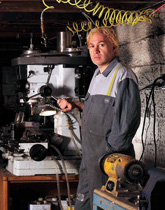
Armed with wire brushes, plastic tubes, and sometimes actual musical instrument components, the young entrepreneur retreats to his basement workshop. The tiny space, sectioned off from the family laundry room by curtains, is crammed with iron filings, computer fans, and industrial metalworking tools that Eric Singer taught himself to use. In fact, he compares mastering the repeated, precision cuts to a musician practicing a sonata. What he hopes emerges from the workshop is music, literally.
Since he was five years old, Singer knew he would be either a musician or an engineer. He even created his first guitar from scratch: a combination of rubber bands and a shoebox. Growing up, he constantly dismantled junk to see if, just maybe, he could make a musical instrument. By the time he was an electrical and computer engineering major at Carnegie Mellon, when most guys his age used the Nintendo Power Glove to play Bad Street Brawler, he pulled it apart to create a device that could generate music. Such ingenuity led Singer (E'88) in 2000 to found LEMUR, the League of Electronic Musical Urban Robots.
To make everything from a plastic fish/saxophone to a vent cap/snare drum, Singer often prowls the aisles of Home Depot looking for "ingredients." The end result is a set of instruments that may look a bit odd but—unlike a player piano—can communicate with a musician.
Whether LEMUR 'bots appear with alternative rock bands or in a museum in Irvine makes no difference. They keep proving to audiences that they can play any song, any tempo, any number of times.
Their growing reputation caught the attention of legendary jazz guitarist Pat Metheny, a 17-time Grammy winner. He commissioned LEMUR to help produce an ambitious project: a jazz album featuring a robotic band. Metheny's hope was that the band would follow his lead and improvise through the varying rhythms essential to jazz. Using something called an MIDI cable (sort of like a USB cable that transmits musical instructions instead of photos or spreadsheets), LEMUR built a band of percussion and guitar robots to connect with either a computer for pre-programmed composing or Metheny's guitar for on-the-spot instructions. Singer assured Metheny that, like the adapted Power Glove, these 'bots could improvise.
To find out if that was the case, Metheny rented a church in New York City, to ensure perfect acoustics for his rehearsal. The musician sat before the altar, eyes closed in concentration, and plucked out a song on his guitar. As the melody picked up momentum, the 'bots joined in. Metheny got more comfortable and began to play around with the melody, jamming with the 'bots. Whether the guitarist altered the tempo or repeated a phrase, the robots stayed in rhythm. Singer, seated in a pew, breathed a sigh of relief. By the end of the session, Metheny proclaimed he was ready to make a record with his new bandmates.
The album, Orchestrion, was released earlier this year to favorable reviews. Metheny and his LEMUR 'bots are currently on a worldwide tour performing and promoting the album.
—Katy Rank Lev
For more information:
Robotics Instruments make music



